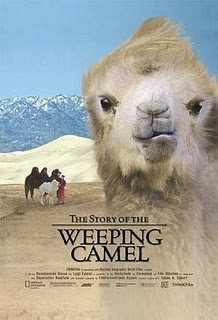The Story of the Weeping Camel facts for kids
Quick facts for kids The Story of the Weeping CamelИнгэн нулимс |
|
|---|---|
 |
|
| Directed by | Byambasuren Davaa Luigi Falorni |
| Produced by | Tobias Siebert |
| Written by | Byambasuren Davaa Luigi Falorni |
| Starring | Janchiv Ayurzana Chimed Ohin |
| Music by | Marcel Leniz Marc Riedinger Choigiw Sangidorj |
| Cinematography | Luigi Falorni |
| Editing by | Anja Pohl |
| Studio | Mongolkina |
| Distributed by | Prokino Filmverlieh (Germany) New Yorker Films ThinkFilm (US) |
| Release date(s) | 6 September 2003 (Toronto) 8 January 2004 (Germany) |
| Running time | 87 minutes |
| Country | Germany Mongolia |
| Language | Mongolian |
| Money made | $9,328,652 |
The Story of the Weeping Camel is a special kind of movie called a docudrama. It mixes real-life events with a story. This film came out in 2003 in Germany and then worldwide in 2004. It was directed and written by Byambasuren Davaa and Luigi Falorni.
The movie is about a family of nomadic shepherds. They live in the Gobi Desert in Mongolia. Their story shows how they try to save a rare white baby camel. The mother camel has rejected her newborn calf.
Plot Summary
In the spring, a family of nomadic shepherds helps their camels give birth. The last camel to have a baby this season has a very long labor. It lasts for two days. With the family's help, a rare white calf is born. This is the mother camel's first baby.
Even with the shepherds' hard work, the mother camel does not accept her newborn. She refuses to let it drink her milk. She also does not show any care for it.
Seeking Help for the Camel
To help the mother and baby camel, the family calls for some lamas. Lamas are Buddhist spiritual teachers. They perform a special ritual. They use bread or dough figures called torma. These figures look like the mother camel, the calf, and the family members.
The ritual begins with the sound of a sacred conchshell horn. Then, bells ring in the lamas' hands. Some lamas also hold a vajra, which is a special ritual object. Many people from the nomadic community join in. The ritual takes place at a sacred spot. This spot has a wooden pole standing up. It looks like a "victory banner" (called Dhvaja). A blue cloth is wrapped around it, like a prayer flag. Rocks support the pole at its base. However, this ritual does not bring the mother and baby camel together.
The Hoos Ritual
The family then decides to try another way. They want to find a musician to play for a Mongolian 'Hoos' ritual. They send their two young boys on a trip. The boys travel through the desert to the community marketplace. Their goal is to find a musician.
The musician plays a morin khuur. This is a traditional Mongolian string instrument. It is sometimes called a horsehead fiddle. The musician comes to the family's camp. A ritual of folk music and chanting begins.
First, the musician places the morin khuur on the camel's first hump. This is meant to create a special connection. It links the camel to the harmony the instrument represents. After this, the musician starts to play. As the music plays, a female family member sings. She sings the calming sounds and beautiful melody of the 'Hoos'. She had sung a lullaby to her child earlier in the film.
At this point, something amazing happens. The mother camel starts to cry. Tears can be seen streaming from her eyes. Right after this ritual, the mother and baby camel are reunited. The baby camel is finally able to drink its mother's milk.
Awards and Recognition
This documentary was nominated for a very important award. It was nominated for an Oscar for Best Documentary. This happened at the 77th Academy Awards.
The film also won other awards:
- International Film Critics Award, 2004 San Francisco International Film Festival
- White Camel Award, 2006 Sahara International Film Festival
See also
 In Spanish: La historia del camello que llora para niños
In Spanish: La historia del camello que llora para niños

